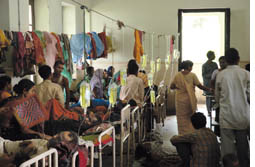World malaria report 2023
<p>India topped countries in the South-East Asia region for the most number of malaria cases and deaths in 2022, according to this report published by the World Health Organization (WHO).</p>
<p>India topped countries in the South-East Asia region for the most number of malaria cases and deaths in 2022, according to this report published by the World Health Organization (WHO).</p>
A map, which pin-points the location of India's remote villages worst affected by malaria, will now spearhead the country's war against the vector-borne disease.
For years the global malaria effort has been asking for more resources.Now the field needs to figure out a systematic strategy for spending the money effectively.
With money now flowing in, the fight against malaria must shift from advocacy to getting results. (Editorial)
With 1.67 million cases of malaria and around 1,000 deaths last year, the government has changed the drug policy and directed states from January this year to introduce the ACT (artesunate and sulpha pyrimethamine) combination as the first line of anti-malarial drug treatment in chloroquine-resistant areas. Dr G S Sonal, Joint Director, National Vector Borne Disease Control Programme (NVDCP), told The Indian Express that there has been concern over the increasing number of plasmodium falciparum (PF) cases of malaria. India contributes to 77 per cent cases of malaria in South East Asia. PF in the 70s amounted to less than 15 per cent of the malaria cases, but this has now gone up to 50 per cent of the total malaria cases. Moreover the dangerous PF has developed resistance to chloroquine in various parts of the country. Sixty-five per cent of cases of malaria in various pockets of Orissa, Madhya Pradesh, Chhattisgarh, Jharkhand and West Bengal are due to PF and drug resistance to chloroquine is high here. Chloroquine however is useful in states like Haryana, Punjab, Jammu and Kashmir and Himachal Pradesh. At least one million ACT course drugs will be supplied to the high endemic states. So far the government had supplied 20 crore tablets of chloroquine in the country. This quantum of drugs will be slightly reduced, Sonal said. According to Dr A P Dash, Director, National Institute of Malaria Research (NIMR), the PF species of malaria is spreading wider due to migration of population from endemic to non-endemic areas and drug sensitivity studies from various states have observed that there is resistance to the drug chloroquine - which is being used as the first line of treatment for malaria cases. The last time the policy was revised was in 2003. Vaccine for malaria Two sites have been selected for trial of a vaccine against malaria. Epidemiological and immunological data will be collected from the sites selected in Orissa and Madhya Pradesh to test the vaccine. The International Centre for Genetic Engineering and Biotechnology, Delhi, has developed the vaccine and will be tested at these two sites, Director, National Institute of Malaria Research Dr A P Dash said.
Eco Bio Blocks being used in the treatment of sewage water as part of a pilot project launched in Alandur Municipality on Monday.
a mystery fever has hit Saharanpur and its neighbouring districts in western Uttar Pradesh. By October 15, the disease had afflicted 52 children, of whom 29 succumbed. Over the past two decades,

malaria treatment has so far been uniform globally. who guidelines on symptoms of severe malaria are based on symptoms found in children in Africa. They include anaemia, jaundice and hypoglycaemia

New research says the Nile tilapia can fight mosquitoes carrying malaria. The edible fish, Oreochromis niloticus, is commonly farmed and consumed in Africa's Kenyan highlands. Though larva-eating

kala-azar is spreading. Two cases of the disease, usually found in eastern parts of India, have been reported from Gujarat and Madhya Pradesh. The pathogen could spread in the area because
Long-lasting insecticidal bednets (LLINs) are one of the major ways to control malaria, and they are widely accepted worldwide by communities in areas affected by malaria. One LLIN costs about US$5 to manufacture and is effective for about 5 years.